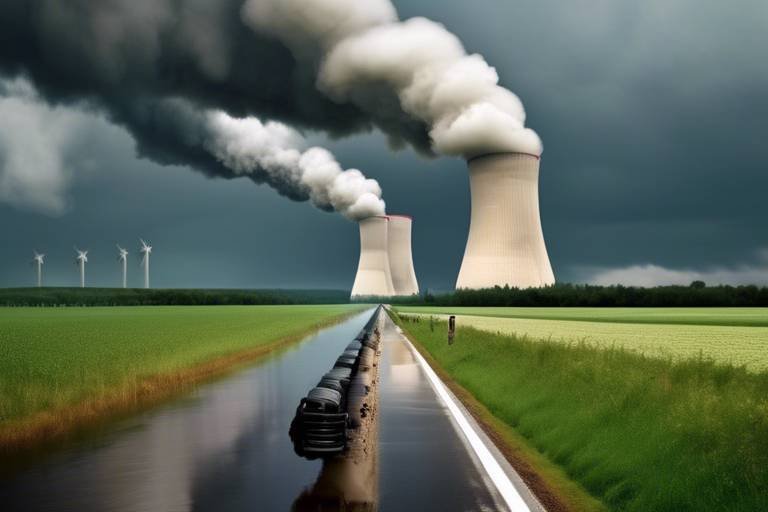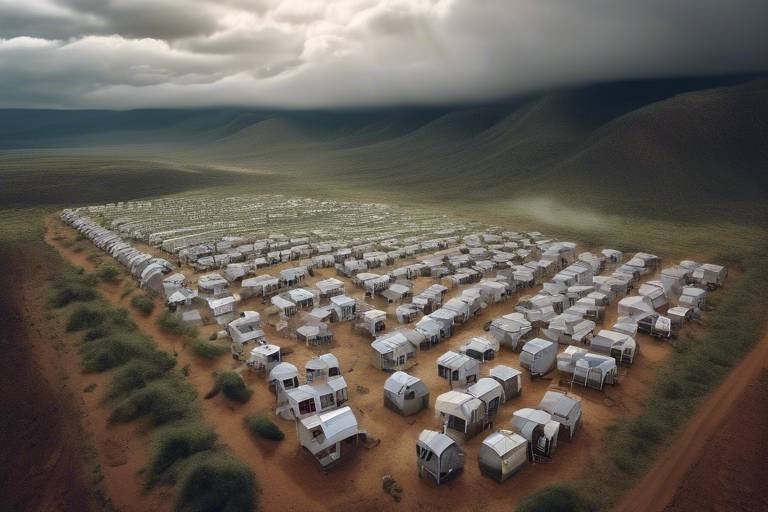How the Meat Industry Contributes to Water Scarcity
The meat industry is often celebrated for its role in providing protein-rich foods, but have you ever stopped to think about the **hidden costs** associated with meat production? One of the most alarming impacts is its significant contribution to **water scarcity**. As the global population continues to rise, so does the demand for meat, which in turn places an enormous strain on our already limited water resources. In this article, we’ll delve into the intricate relationship between meat production and water scarcity, exploring how various processes within the industry exacerbate this pressing issue.
Water is a finite resource, and the way we produce meat can lead to **alarming levels of depletion** in freshwater supplies. The term "water footprint" refers to the total volume of freshwater used to produce goods, and when it comes to meat, this footprint can be staggering. For instance, producing just one kilogram of beef can require over 15,000 liters of water! This includes water for the animals themselves, as well as the water needed to grow their feed. Understanding the **water footprint** of different types of meat is crucial for grasping the overall impact of the industry on our planet’s water resources.
In addition to the direct water consumption associated with livestock, we must also consider the **indirect water usage** involved in feed production. Livestock farming requires vast quantities of water not just for drinking and cleaning, but also for the irrigation of feed crops. This means that the meat industry is not just a consumer of water; it’s also a significant driver of water scarcity in regions where water is already a precious commodity. The challenge is compounded by **monoculture practices**, where large areas are dedicated to a single crop, leading to soil degradation and an increased demand for water. This creates a vicious cycle where the very practices intended to maximize production end up exacerbating the problem.
Moreover, the effects of **climate change** cannot be ignored. Changes in weather patterns, increased temperatures, and prolonged droughts are making water availability even more unpredictable. As farmers struggle to secure enough water for their crops, the livestock that depend on these crops face dire consequences. This not only affects the animals but also poses a risk to food security and local economies. The question arises: how can we continue to meet the global demand for meat without further straining our water resources?
Another critical aspect to consider is the pollution caused by animal waste. When livestock farms produce waste, it often runs off into nearby water sources, contaminating them and making clean water even scarcer for surrounding communities. This pollution can lead to a host of health problems for residents and can severely impact local ecosystems. Therefore, tackling water scarcity in the context of the meat industry isn't just about reducing water use; it’s also about mitigating **water pollution** from agricultural practices.
As we examine the complex relationship between the meat industry and water scarcity, it becomes clear that regional variations play a significant role. Some areas, particularly those already facing water stress, are hit harder by intensive livestock farming practices. For example, regions like the American Southwest and parts of Australia are experiencing severe water shortages, and the meat industry’s practices are a contributing factor. By looking at case studies from these regions, we can see a direct correlation between meat production and the depletion of local water resources.
Addressing these issues requires not just awareness but also **effective policy responses** and sustainable practices within the meat industry. Solutions could include promoting alternative protein sources, improving water management practices in agriculture, and encouraging consumers to make more sustainable dietary choices. It’s vital for all stakeholders—from farmers to consumers—to come together to find solutions that can reduce the meat industry's impact on our precious water resources.
- What is the water footprint of meat? The water footprint of meat refers to the total amount of freshwater used in the production of meat, including water for the animals and the crops grown to feed them.
- How does livestock farming contribute to water scarcity? Livestock farming consumes large amounts of water for drinking, cleaning, and irrigation of feed crops, which can lead to regional water shortages.
- What are the environmental impacts of animal waste? Animal waste can contaminate local water supplies, leading to pollution and health risks for nearby communities.
- How can we mitigate the impact of the meat industry on water resources? Solutions include adopting sustainable farming practices, promoting alternative protein sources, and improving water management in agriculture.

The Water Footprint of Meat Production
The water footprint of meat production is a staggering indicator of how much water is consumed in the process of raising livestock. It's not just about the water the animals drink; it's a complex web of water usage that encompasses everything from the irrigation of feed crops to the water needed for processing meat. In fact, studies suggest that producing just one kilogram of beef requires approximately 15,000 liters of water. This figure is not just a number; it represents the immense resources we are using to satisfy our dietary preferences.
To put this into perspective, consider the water footprint of other meats. Chicken, for example, requires about 4,300 liters per kilogram, while pork sits at around 6,000 liters. These numbers highlight a significant disparity in water usage across different types of meat, making it crucial for consumers to understand the implications of their dietary choices. The sheer volume of water involved in meat production raises important questions about sustainability and resource management in a world where water scarcity is becoming increasingly prevalent.
Moreover, the water footprint varies not only by type of meat but also by production methods and geographical location. For instance, livestock raised in arid regions often require more water due to the lack of natural resources, which exacerbates local water scarcity issues. This means that the environmental impact of meat production is not uniform; it is a complex issue that demands a nuanced understanding of agricultural practices and their consequences on water resources.
Additionally, the concept of the water footprint extends beyond direct consumption. It includes the indirect water used in the production of feed crops, which can account for a significant portion of the total water used in meat production. For example, crops like corn and soybeans, which are commonly used as animal feed, require large amounts of water for irrigation. In many cases, the water used for these crops can be several times greater than the water needed for the livestock themselves. This indirect water usage is often overlooked, yet it plays a pivotal role in the overall water footprint of meat production.
As we delve deeper into the environmental implications of meat production, it's essential to recognize the role of consumer behavior. By understanding the water footprint associated with different types of meat, consumers can make more informed choices that contribute to water conservation. Reducing meat consumption, opting for more sustainable sources, or supporting local farms that practice water-efficient methods can significantly decrease the overall water demand of our diets. Every little change can ripple out, leading to substantial benefits for our water resources.
| Type of Meat | Water Footprint (liters per kg) |
|---|---|
| Beef | 15,000 |
| Pork | 6,000 |
| Chicken | 4,300 |
In summary, the water footprint of meat production is a critical aspect of understanding the environmental impact of our dietary choices. As we face growing concerns about water scarcity, it becomes increasingly important to evaluate how our food systems operate and to advocate for practices that promote sustainability. By being conscious of the water implications of meat production, we can work together towards a more sustainable future.

Water Usage in Livestock Farming
The livestock farming sector is notorious for its hefty water consumption, which often goes unnoticed by the average consumer. When we think about water usage, we might picture a farmer watering crops or a family filling their swimming pool. However, the reality is far more complex and alarming. Livestock farming is a significant contributor to water scarcity, consuming vast amounts of freshwater for various purposes. From drinking water for the animals to the water needed for cleaning and maintaining hygiene, the numbers can be staggering. In fact, it takes approximately 1,800 gallons of water to produce just one pound of beef. This includes the water used for drinking, cleaning, and the irrigation of feed crops.
To put this into perspective, let’s break down the water usage in livestock farming. Animals require water not just for hydration but also for maintaining their health and productivity. For instance, a dairy cow can consume around 30 to 50 gallons of water per day, depending on its size and milk production. This is just the tip of the iceberg, as the water footprint extends far beyond the animals themselves.
Additionally, the cleaning and sanitation processes on farms demand significant water resources. Keeping livestock areas clean is crucial for preventing disease, which means that farmers must regularly wash down barns, pens, and equipment. This can add hundreds of gallons of water to the total consumption, further straining local water supplies.
But that’s not all. The feed crops grown to sustain livestock also require extensive irrigation. For example, it takes about 1,200 gallons of water to produce a single pound of corn, a primary feed source for many livestock. This indirect water usage often goes unaccounted for, yet it plays a critical role in understanding the overall impact of the meat industry on water resources.
Moreover, the geographical location of livestock farming can dramatically influence water availability. Regions that are already experiencing water stress, such as the Southwest United States or parts of India, face additional challenges when large-scale livestock operations are introduced. The competition for water between livestock farming and local communities can lead to severe shortages, affecting not just the farmers but also the residents who depend on these water sources for their daily needs.
In conclusion, the water usage in livestock farming is a multifaceted issue that intertwines animal husbandry practices with environmental sustainability. As consumers, it’s crucial to be aware of the hidden costs of our dietary choices. By understanding the extensive water footprint associated with meat production, we can make more informed decisions and advocate for sustainable practices that prioritize both animal welfare and water conservation.

Feed Crop Irrigation
The irrigation of feed crops is a pivotal aspect of the meat production process, and it carries a significant weight when it comes to understanding the overall water usage in the meat industry. To put it simply, the water required to grow feed for livestock is staggering. In fact, it is estimated that producing just one kilogram of beef can consume up to 15,000 liters of water, with a substantial portion of that water being used to irrigate the crops that feed the animals. This indirect water consumption often goes unnoticed, yet it plays a crucial role in exacerbating global water scarcity.
When we consider the sheer volume of water needed for irrigation, it becomes clear that the choices made in agricultural practices can either alleviate or worsen water scarcity issues. For instance, traditional irrigation methods are often inefficient, leading to a significant loss of water through evaporation and runoff. This inefficiency is particularly evident in regions where water is already a limited resource. Farmers may rely on outdated techniques that waste precious water, leaving local communities struggling to access clean water for their own needs.
Moreover, the type of crops grown for animal feed can further complicate the issue. Many livestock operations depend on high-water-demand crops such as corn and soybeans. These crops not only require extensive irrigation but also contribute to soil degradation and nutrient depletion, which can diminish the land's ability to retain water over time. The cycle continues, as farmers may then need to use even more water to compensate for the loss of soil quality, creating a vicious cycle that threatens both agricultural productivity and water availability.
In addition to these challenges, the geographic distribution of feed crop irrigation can lead to regional disparities in water availability. Some areas are heavily irrigated for feed production, while others face acute water shortages. This uneven distribution can create tensions between agricultural needs and community water needs, especially in arid regions where every drop counts. For example, in parts of the American West, the competition for water resources between livestock operations and local municipalities can lead to conflicts and sustainability concerns.
To address these issues, innovative solutions are necessary. Techniques such as drip irrigation and rainwater harvesting can significantly improve water efficiency in feed crop production. By implementing these methods, farmers can reduce their water consumption while still meeting the demands of livestock farming. Additionally, shifting towards more sustainable feed crops that require less water can help alleviate the pressure on freshwater resources.
Ultimately, the impact of feed crop irrigation on water scarcity cannot be overstated. As consumers, we must be aware of the water implications of our meat consumption choices. By advocating for sustainable practices and supporting policies that prioritize water conservation in agriculture, we can contribute to a more balanced relationship between meat production and water resources. The future of our water supply may depend on it.
- What is the water footprint of meat production? The water footprint of meat production varies by type of meat, with beef requiring significantly more water than poultry or pork.
- How does feed crop irrigation affect local water supplies? Feed crop irrigation can deplete local water supplies, especially in regions already facing water scarcity.
- What are some sustainable practices for reducing water use in livestock farming? Techniques such as drip irrigation, rainwater harvesting, and using drought-resistant feed crops can help reduce water consumption.
- Why is it important to consider the water usage of the meat industry? Understanding the water usage of the meat industry is crucial for addressing global water scarcity and ensuring sustainable food production.

Impact of Monoculture Practices
The impact of monoculture practices in agriculture, particularly in the context of livestock feed production, is both profound and concerning. Monoculture refers to the agricultural practice of growing a single crop over a wide area for many consecutive years. While this method may seem efficient at first glance, it has significant repercussions on the environment, especially concerning water scarcity. When farmers focus on a single crop, such as corn or soybeans, they often neglect the diversity that is crucial for maintaining healthy ecosystems. This lack of biodiversity can lead to soil degradation, making the land less productive over time and requiring even more water to sustain crop yields.
Moreover, the reliance on monoculture increases the demand for irrigation. Since these crops often require substantial amounts of water, farmers are forced to extract more from local water sources, which can lead to over-extraction and depletion of aquifers. To illustrate, a study found that producing one kilogram of beef can require up to 15,000 liters of water, much of which is used for growing feed crops. This creates a vicious cycle where more water is needed to grow the same crop year after year, ultimately exacerbating water scarcity issues.
Additionally, monoculture practices can lead to increased vulnerability to pests and diseases, which in turn prompts farmers to use more chemical fertilizers and pesticides. These chemicals can run off into nearby water bodies, causing pollution and further complicating the availability of clean water for local communities. In essence, the very practices that aim to maximize agricultural output are often at odds with sustainable water management.
To put it simply, monoculture is like putting all your eggs in one basket. While it may seem like a practical approach to farming, it can lead to significant environmental repercussions, particularly in terms of water usage and quality. The long-term effects of these practices can be devastating, not just for the environment but also for the communities that rely on these water sources for their daily needs. By shifting towards more sustainable agricultural practices that promote crop diversity, we can help alleviate some of the pressure on our precious water resources.

Climate Change and Water Availability
Climate change is not just a buzzword; it's a reality that is reshaping our planet and its resources. One of the most concerning impacts of climate change is its direct effect on water availability. As global temperatures rise, weather patterns become increasingly unpredictable, leading to extreme weather events such as droughts and floods. These changes pose significant challenges for the meat industry, which relies heavily on consistent water supplies for livestock and feed crop irrigation.
To put things into perspective, consider this: the interconnectedness of climate and water resources is akin to a delicate web. When one strand is pulled—like the rising temperatures from climate change—it affects the entire structure. For instance, regions that traditionally had ample rainfall may now experience prolonged dry spells, drastically reducing the water available for agriculture. This is particularly alarming for livestock farmers who depend on regular water sources for their animals and crops.
Moreover, the altered precipitation patterns can lead to a situation where some areas receive too much water while others suffer from severe shortages. This imbalance can exacerbate existing water scarcity issues, especially in regions already grappling with limited resources. Farmers may find themselves in a dilemma: how to manage their livestock when water is either too scarce or too abundant, leading to flooding that can devastate crops and infrastructure.
Additionally, the stress on water resources is compounded by the rising demand for meat as populations grow and diets shift. The result is a perfect storm where climate change and the meat industry collide, creating a scenario that threatens not just water availability, but also food security and the health of ecosystems. As we continue to grapple with these challenges, it becomes crucial to implement sustainable practices within the meat industry that can adapt to the realities of a changing climate.
In light of these challenges, innovative solutions and policies are essential. For instance, adopting water-efficient agricultural practices can help mitigate some of the adverse effects of climate change. Techniques such as rainwater harvesting, drip irrigation, and crop rotation can optimize water use and enhance resilience against climate variability. These practices not only conserve water but also improve soil health, making farms more sustainable in the long run.
Ultimately, addressing the complexities of climate change and water availability requires a collaborative effort from governments, industries, and consumers alike. By understanding the intricate relationship between climate change and water resources, we can work towards solutions that ensure a sustainable future for the meat industry and the planet.
- How does climate change affect water availability? Climate change leads to altered weather patterns, resulting in unpredictable rainfall and increased occurrences of droughts and floods, which can significantly impact water supply.
- What role does the meat industry play in water scarcity? The meat industry consumes vast amounts of water for livestock and feed production, contributing to regional water shortages, especially in areas already facing water stress.
- What sustainable practices can be adopted in the meat industry? Practices such as rainwater harvesting, efficient irrigation methods, and crop rotation can help conserve water and improve resilience against climate impacts.

Water Pollution from Animal Waste
The issue of is a critical concern that cannot be overlooked when discussing the meat industry's impact on our precious water resources. As livestock farming intensifies to meet the ever-growing demand for meat, the amount of waste produced by these animals increases dramatically. This waste, often laden with harmful pathogens, nutrients, and chemicals, can find its way into local waterways, leading to severe environmental consequences.
When animals are raised in concentrated animal feeding operations (CAFOs), the sheer volume of waste generated is staggering. For instance, a single dairy cow can produce approximately 120 pounds of manure each day. Multiply that by thousands of cows, and you have a significant amount of waste that needs to be managed. Unfortunately, much of this waste is not treated properly and ends up contaminating nearby rivers, lakes, and groundwater.
One of the primary pollutants in animal waste is nitrogen, which can lead to a phenomenon known as eutrophication. This process occurs when excess nitrogen enters water bodies, fueling the growth of algae blooms. These blooms can deplete oxygen levels in the water, making it difficult for aquatic life to survive. As a result, fish kills and a decline in biodiversity can occur, disrupting entire ecosystems.
Moreover, the runoff from farms can introduce pathogens such as E. coli and Salmonella into water supplies, posing significant health risks to nearby communities. Imagine a family relying on a local river for drinking water, only to discover that it has been contaminated by runoff from a nearby farm. This scenario is all too common in regions where livestock farming is prevalent.
To illustrate the extent of this issue, consider the following table that highlights the sources of water pollution from animal waste:
| Pollutant | Source | Impact on Water |
|---|---|---|
| Nitrogen | Animal manure | Eutrophication, algae blooms |
| Phosphorus | Feed runoff | Water quality degradation |
| Pathogens | Animal waste | Health risks to humans and wildlife |
Addressing water pollution from animal waste requires a multifaceted approach. Farmers can implement better waste management practices, such as using composting methods or constructing anaerobic digesters to treat waste before it reaches water bodies. Additionally, regulatory frameworks need to be strengthened to ensure that livestock operations adhere to strict environmental standards.
In conclusion, the pollution of water resources from animal waste is a pressing issue that stems from the meat industry's practices. By understanding the implications and taking action, we can work towards a more sustainable future that protects our water supplies and the ecosystems that depend on them.
- What is the main cause of water pollution from animal waste?
The primary cause is the runoff from concentrated animal feeding operations (CAFOs) that contain high levels of nutrients and pathogens. - How does water pollution from animal waste affect human health?
Contaminated water can lead to serious health risks, including gastrointestinal illnesses caused by pathogens like E. coli and Salmonella. - What can farmers do to reduce water pollution?
Farmers can adopt better waste management practices, such as composting and using anaerobic digesters, to treat waste effectively.

Regional Variations in Water Scarcity
When we think about water scarcity, it's easy to assume that this is a universal issue affecting everyone equally. However, the reality is far more complex. The impact of the meat industry on water resources varies significantly across different regions, influenced by local climate, agricultural practices, and population density. For instance, in arid regions like the Middle East and North Africa, the demand for water is already strained due to limited natural resources. Here, intensive livestock farming can exacerbate existing water shortages, leading to dire consequences for both the environment and local communities.
In contrast, regions with abundant water resources, such as parts of the Midwest in the United States, may not feel the immediate effects of water scarcity as acutely. However, this does not mean that the meat industry is any less impactful. The sheer volume of water required for meat production—often referred to as the "water footprint"—can still lead to significant depletion of local aquifers over time. This situation creates a ticking time bomb, where the long-term sustainability of water resources is put at risk.
To illustrate this disparity, let's take a closer look at some specific regions and their unique challenges:
| Region | Water Scarcity Level | Meat Production Impact |
|---|---|---|
| Middle East & North Africa | High | Intensive livestock farming exacerbates water shortages. |
| Sub-Saharan Africa | Moderate to High | Rural communities face water competition from livestock. |
| Midwest USA | Low to Moderate | Long-term aquifer depletion from large-scale farming. |
| South Asia | High | Water-intensive feed crops contribute to local scarcity. |
As you can see from the table, the varying levels of water scarcity and the corresponding impacts of meat production highlight the need for tailored solutions. In water-stressed areas, there is an urgent need to adopt more sustainable farming practices. This could include reducing livestock numbers, improving feed crop irrigation efficiency, and promoting alternative protein sources that require less water.
Moreover, it's essential to consider the social ramifications of water scarcity. In many regions, communities reliant on agriculture for their livelihoods are at the mercy of water availability. When livestock farming drains local water supplies, it can lead to conflicts over resources, further complicating the already fragile situation. Therefore, understanding regional variations in water scarcity is not just an environmental issue; it's a matter of social justice and economic stability.
In conclusion, while the meat industry contributes to water scarcity globally, its impact is not uniform. By recognizing these regional differences, we can develop more effective policies and practices that address the unique challenges each area faces. The road to sustainable meat production is long, but it starts with understanding the nuances of water use in agriculture.
- What is the water footprint of meat? The water footprint of meat refers to the total volume of freshwater used to produce meat, including water for drinking, cleaning, and growing feed crops.
- How does livestock farming affect local water supplies? Livestock farming requires significant water for various purposes, leading to depletion of local water resources and potentially causing shortages for communities.
- What can be done to mitigate water scarcity in regions affected by meat production? Sustainable farming practices, reducing livestock numbers, and promoting alternative proteins can help alleviate water scarcity issues.

Case Studies from Water-Stressed Regions
The relationship between the meat industry and water scarcity becomes alarmingly clear when we examine specific case studies from regions grappling with acute water stress. One striking example is the Central Valley of California, a major agricultural hub that produces a significant portion of the United States' meat and dairy products. Here, the competition for water between livestock farming and urban needs has led to severe water shortages. Farmers often resort to pumping groundwater, which is not only unsustainable but also leads to long-term environmental degradation.
Another poignant case is that of Australia's Murray-Darling Basin, where over-extraction of water for irrigation has caused rivers to run dry. The basin supports a large livestock population, and the demand for water to grow feed crops has exacerbated the situation. The impact of this intensive farming is felt not just by farmers but by entire communities that rely on these water sources for drinking and sanitation. As water levels plummet, the ecosystem suffers, leading to a decline in biodiversity and the health of local wildlife.
In India, the situation is equally concerning. The country has seen a dramatic increase in meat consumption, leading to a surge in livestock farming. Regions like Punjab and Haryana are witnessing the consequences of this growth. The excessive water usage for both livestock and feed crops has resulted in significant depletion of groundwater resources. Farmers, often unaware of the long-term effects, continue to use water-intensive methods, unaware that they are jeopardizing their future agricultural viability.
To illustrate the gravity of these situations, consider the following table that summarizes the water usage associated with meat production in these regions:
| Region | Primary Meat Type | Water Usage (liters per kg of meat) | Impact on Local Water Resources |
|---|---|---|---|
| Central Valley, California | Beef | 15,000 | Severe groundwater depletion |
| Murray-Darling Basin, Australia | Lamb | 10,000 | Rivers running dry |
| Punjab, India | Poultry | 4,300 | Groundwater depletion |
These case studies demonstrate not just the direct impact of livestock farming on water scarcity, but also the broader implications for communities and ecosystems. As we delve deeper into these issues, it raises an important question: how can we balance the demand for meat with the urgent need to conserve our precious water resources? The answer lies in adopting sustainable practices and policies that prioritize both food production and environmental stewardship.
- What is the water footprint of meat?
The water footprint of meat refers to the total volume of freshwater used to produce meat, including water for drinking, cleaning, and growing feed crops. - How does livestock farming contribute to water pollution?
Animal waste runoff from farms can contaminate local water supplies, posing health risks to communities and harming aquatic ecosystems. - What can be done to mitigate water scarcity caused by the meat industry?
Implementing sustainable farming practices, reducing meat consumption, and improving water management policies are essential steps to mitigate these impacts.

Policy Responses and Solutions
The urgent need to address water scarcity, exacerbated by the meat industry, calls for robust policy responses and innovative solutions. Governments, organizations, and stakeholders must collaborate to implement strategies that not only mitigate the industry's impact on water resources but also promote sustainability. One of the most effective approaches is the establishment of water use regulations specific to livestock farming. By setting limits on the amount of water that can be used for various farming activities, authorities can ensure that water resources are managed more effectively. This can include restrictions on irrigation practices and mandatory water conservation measures during periods of drought.
Moreover, transitioning to sustainable farming practices can significantly reduce water consumption. For instance, implementing integrated crop-livestock systems allows farmers to optimize water use by recycling nutrients and water between crops and livestock. This not only enhances productivity but also lessens the overall water footprint of meat production. Additionally, promoting diversified feed crops can help alleviate the pressure on water resources. By encouraging farmers to grow a variety of crops instead of relying solely on monocultures, we can enhance soil health and reduce the water needed for irrigation.
Another critical aspect of addressing water scarcity is the need for education and awareness. Farmers should be informed about the impact of their practices on water resources and trained in water-efficient techniques. Workshops, training programs, and educational campaigns can empower farmers to adopt practices that conserve water and protect local ecosystems. Furthermore, consumers play a vital role in this equation. By choosing sustainably produced meat and reducing overall meat consumption, individuals can drive demand for more responsible farming practices. This shift can lead to a cultural change in how society views meat consumption and its environmental implications.
Lastly, government incentives can encourage the adoption of water-saving technologies and practices in the meat industry. Financial support for farmers who implement sustainable practices, such as rainwater harvesting systems or advanced irrigation technologies, can make a substantial difference. These incentives not only help farmers reduce their water usage but also foster a sense of responsibility towards the environment.
In conclusion, the path to mitigating the meat industry's impact on water scarcity is multifaceted, requiring coordinated efforts from policymakers, farmers, and consumers alike. By embracing sustainable practices, enforcing regulations, and fostering education, we can work together to protect our vital water resources for future generations.
- How does meat production affect water resources? Meat production requires significant water for livestock, feed crops, and processing, contributing to water scarcity.
- What are some sustainable practices in livestock farming? Sustainable practices include integrated crop-livestock systems, diversified feed crops, and efficient irrigation methods.
- How can consumers help reduce water usage in the meat industry? Consumers can help by choosing sustainably sourced meat and reducing overall meat consumption.
- What role do governments play in addressing water scarcity? Governments can implement regulations, provide incentives for sustainable practices, and promote education on water conservation.
Frequently Asked Questions
- What is the water footprint of meat production?
The water footprint of meat production refers to the total volume of freshwater used to produce meat, including water for drinking, cleaning, and irrigation of feed crops. It's astonishing to realize that producing just one kilogram of beef can require over 15,000 liters of water! This includes not only the water consumed by the cattle but also the water needed to grow their feed.
- How does livestock farming contribute to water scarcity?
Livestock farming contributes to water scarcity in several ways. Firstly, it requires vast amounts of water for the animals themselves, as well as for cleaning and maintaining facilities. Secondly, the irrigation of crops to feed the livestock consumes significant amounts of freshwater. This dual demand can lead to regional shortages, especially in areas already struggling with water availability.
- What role does feed crop irrigation play in water usage?
Feed crop irrigation is a major consumer of freshwater resources, often overshadowed by the direct water needs of livestock. The cultivation of feed crops like corn and soybeans requires substantial irrigation, which can strain local water supplies. The indirect water use through feed crops significantly amplifies the overall water footprint of meat production.
- How do monoculture practices affect water resources?
Monoculture farming practices, where a single crop is grown repeatedly on the same land, can lead to soil degradation and increased water demand. This practice often results in reduced soil fertility and higher susceptibility to pests, which in turn requires more water for irrigation and chemical treatments, exacerbating water scarcity issues in agricultural regions.
- What impact does climate change have on water availability for livestock?
Climate change complicates water availability for livestock farming by causing unpredictable weather patterns, including droughts and floods. These changes can diminish the water supplies critical for both livestock and their feed crops. In essence, as the climate changes, the reliability of water sources for meat production becomes increasingly uncertain.
- How does animal waste contribute to water pollution?
Animal waste runoff from farms can contaminate local water supplies, creating significant challenges for communities that rely on clean water. When waste is not managed properly, it can lead to nutrient pollution, harmful algal blooms, and the spread of pathogens, all of which pose serious health risks to both humans and ecosystems.
- Why do regional variations in water scarcity matter?
Regional variations in water scarcity are crucial because they highlight the differing impacts of the meat industry across the globe. Some areas experience severe water shortages due to intensive livestock farming practices, while others may have more sustainable practices in place. Understanding these variations can help in formulating targeted solutions to alleviate water stress in the most affected regions.
- What are some policy responses to mitigate water scarcity in the meat industry?
Addressing water scarcity in the meat industry requires effective policy responses such as promoting sustainable farming practices, enforcing stricter waste management regulations, and encouraging the use of alternative protein sources. By implementing these strategies, we can work towards reducing the meat industry's impact on water resources and ensuring a more sustainable future.



















